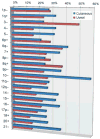The genetics of uveal melanoma: an emerging framework for targeted therapy
- PMID: 22268848
- PMCID: PMC4470256
- DOI: 10.1111/j.1755-148X.2012.00979.x
The genetics of uveal melanoma: an emerging framework for targeted therapy
Abstract
Uveal melanoma is the second most common form of melanoma and the most common primary intraocular malignancy. Until recently, very little was known about the genetics of this aggressive cancer. Mutations in oncogenes and tumor suppressors that are common in other cancers are conspicuously absent in uveal melanoma. In recent years, however, uveal melanoma has begun to yield its secrets, and a fascinating picture is emerging of how it develops and progresses. Mutations in the G(q) alpha subunits, encoded by GNAQ and GNA11, appear to be early or perhaps initiating events that require further mutations for malignant transformation. On the other hand, mutations in the BRCA1-associated protein-1 (BAP1) appear to occur later and demarcate a molecular brink beyond which metastasis becomes highly likely. BAP1 mutations can also occur in the germline, leading to a distinctive cancer predisposition syndrome. These mutations appear to be key events that provide the potential for targeted therapy. This article will review the genetic findings in uveal melanoma over the past two decades and suggest important areas for future work.
© 2012 John Wiley & Sons A/S.
Figures



References
-
- Aalto Y, Eriksson L, Seregard S, Larsson O, Knuutila S. Concomitant loss of chromosome 3 and whole arm losses and gains of chromosome 1, 6, or 8 in metastasizing primary uveal melanoma. Invest Ophthalmol Vis Sci. 2001;42:313–317. - PubMed
-
- Abdel-Rahman MH, Yang Y, Zhou XP, Craig EL, Davidorf FH, Eng C. High frequency of submicroscopic hemizygous deletion is a major mechanism of loss of expression of PTEN in uveal melanoma. J Clin Oncol. 2006;24:288–295. - PubMed
-
- Augsburger JJ, Gamel JW. Clinical prognostic factors in patients with posterior uveal malignant melanoma. Cancer. 1990;66:1596–1600. - PubMed
-
- Augsburger JJ, Correa ZM, Shaikh AH. Effectiveness of treatments for metastatic uveal melanoma. Am J Ophthalmol. 2009;148:119–127. - PubMed
Publication types
MeSH terms
Substances
Grants and funding
LinkOut - more resources
Full Text Sources
Other Literature Sources
Medical
Research Materials
Miscellaneous

